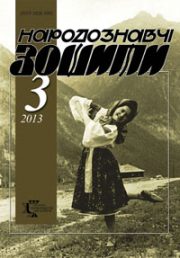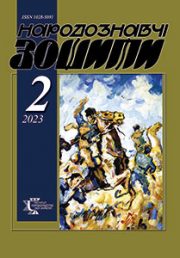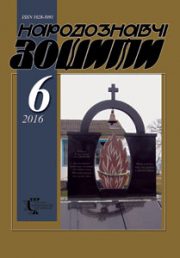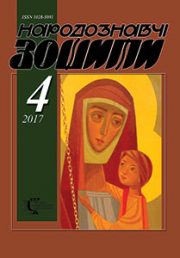The Ethnology Notebooks. 2023. № 3 (171), 697—718
UDK [7.046.3:27-526.62-549](477)”16/17″:930
DOI https://doi.org/10.15407/nz2023.03.697
SYVAK Vasyl
- ORCID ID: https://orcid.org/0009-0003-7450-6776
- Senior Lecturer,
- Lviv National Academy of Arts,
- Department of Sacred Art,
- 38 Kubiyovycha St., 79011, Lviv, Ukraine,
- Contacts: e-mail: Vasylkosyvak@gmail.com
Abstract. There is no comprehensive scientific study in Ukrainian art history that would cover the entire range of issues of Eucharistic iconography in Ukrainian art of the 17th—18th centuries. An in-depth analysis of primary sources and available scientific publications on the outlined topic makes it possible to study unexplored or little-researched areas, which proves the relevance of the proposed topic. The purpose of the work is to analyze the historiography of the stated topic. The object of research is Eucharistic iconography, highlighted in works of Ukrainian art, theological and scientific works. The chronological boundaries of the work cover the 17th—18th centuries.
The subject of the study is the state of disclosure of the proposed problem, highlighted in the sources and scientific literature. The territory of the study covers the western, partly northern, eastern and central lands of Ukraine, where monuments of sacred art, tangential to our topic, have been most preserved and spread. For a wider range of study of the relevant materials and for the comparative characterization of the monuments, we will analyze the works of foreign researchers in which related facts are reflected.
The general scientific principles of historicism, systematicity, and scientific objectivity became the methodological basis of the research, which made it possible to carry out the necessary scientific analysis of published works, as well as its individual aspects.
Keywords: Eucharist, icon, Eucharistic iconography, symbolism, allegory, historiography, theology, engraving, carving.
Received 13.06.2023
REFERENCES
- Solovyi, M. (1999). Divine Liturgy. History. Development. Explanation. Lviv: Svichado [in Ukrainian].
- Katrii, Yu. (2009). ChSVV The Divine Liturgy is the source of holiness. Lviv: Missioner [in Ukrainian].
- Whybru, H. (2000). Orthodox Liturgy. Development of the Eucharistic Byzantine Rite. Biblical and Theological Institute of St. Andrew the Apostle. Moscow [in Russian].
- Schultz, G. (2002). Byzantine liturgy testimony of faith and the meaning of symbols. St. John’s Lavra Monastery. Lviv: Svichado [in Ukrainian].
- Chancellor, M. (2001). Liturgy of the church. Monastery of monks of the Studite statute. Lviv: Svichado [in Ukrainian].
- Taft, R. (2005). Byzantine church rite. A brief outline. Sankt-Peterburh [in Russian].
- Gerosa, L. (2001). Ecclesiastical law. Amateka Textbooks on theology. Monastery of monks of the Studite statute. Lviv: Svichado [in Ukrainian].
- Tuchapets, V. (2003). Essay on Eastern Theology. The theological heritage of the Eastern Fathers of the Church and modern Orthodox theologians in comparison with Western Theology. Ivano-Frankivsk [in Ukrainian].
- Krekhovetskyi, Ya. (2005). Theology and spirituality of the icon. Lviv: Svichado [in Ukrainian].
- Pokrovsky, N. (1892). The Gospel in the monuments of iconography. Moscow: Prohress-Traditsia [in Russian].
- Shmeman, O. (2007). Eucharist. The mystery of the Church. Lviv: Svichado [in Ukrainian].
- Florensky, P. (1972). Iconostasis. Theological works, 9, 80—90 [in Russian].
- Florensky, P. (1974). The concept of the Church in the Holy Scriptures. Dogmatic and exegetical materials for the question of the Church. Theological Works, 12, 78—183 [in Russian].
- Zilinko, R. Iconography of the Sacrament of the Eucharist in Ukrainian sacred art of the 17th — beginning of the 18th century. Retrieved from: http://old.ugcc.org.ua/ukr/library/2005/paper/7/ [in Ukrainian].
- Markovich, K. (2006). Eucharistic theme in the wall painting of the sanctuary of the Eastern Christian temple. Ukrainian Greek Catholic Church and religious art (historical experience and contemporary problems). Scientific collection (Issue 4, pp. 92—102). Materials of the 4th International Scientific Conference. Lviv [in Ukrainian].
- Shiroka, O. (2020). Eucharistic images of Jesus Christ in the Akathist cycles of the Mother of God and Christ in Ukrainian art of the 17th-18th centuries. Art history. Actual issues of humanitarian sciences (Issue 33, vol. 2, pp. 98—103). Kyiv [in Ukrainian].
- Grabar, A. (2003). The first steps of Christian iconography. Art history. Problems of publication, figures, translations, panorama of events (Pp. 187—200). Lviv [in Ukrainian].
- Vlodek, P. (1999). Theology icons. Monuments of sacred art of Volyn on the threshold of millennia: Issues of research, preservation and restoration. Scientific collection. Materials of the 6th international scientific conference on Volyn icon painting. Lutsk, December 1—3, 1999 (Pp. 29—30). Lutsk [in Ukrainian].
- Kolpakova, G. (2005). Art of Byzantium. Early and middle periods. Sankt-Peterburh: Azbuka-klasyka [in Russian].
- Lepakhin, V. (2001). Icon and iconicity. Monastery of monks of the Studite statute. Lviv: Svichado [in Ukrainian].
- Shpidlik, T., & Rupnik, B. (1999). What the icon tells about. Monastery of monks of the Studite statute. Lviv: Svichado [in Ukrainian].
- (2018). Architecture, monumental art. Ecclesiastical art of Ukraine: in three volumes. (Vol. 1). Kharkiv: Folio Folio [in Ukrainian].
- (2021). Visual arts. Ecclesiastical art of Ukraine: in three volumes (Vol. 2). Kharkiv: Folio Folio [in Ukrainian].
- (2021). Decorative arts. Ecclesiastical art of Ukraine: in three volumes (Vol. 3). Kharkiv: Folio Folio [in Ukrainian].
- Ovsiychuk, V. (1985). Ukrainian art of the second half of the 16th — the first half of the 17th century. Humanistic and liberation ideas. Kyiv: Naukova dumka [in Ukrainian].
- Ovsiychuk, V. (1991). Masters of the Ukrainian Baroque. Zhovkiv artistic center. Kyiv [in Ukrainian].
- Ovsiychuk, V. (1996). Ukrainian painting of the 10th—18th centuries. Color problems. Institute of Ethnology of the National Academy of Sciences of Ukraine. Lviv [in Ukrainian]
- Ovsiychuk, V. (2001). Classicism and romanticism in Ukrainian art. Kyiv: Dnipro [in Ukrainian].
- Ovsiychuk, V. (2004). Western Ukrainian Baroque painting. Ukrainian Baroque: typology and specifics (Vol. І, pp. 571—632) [in Ukrainian].
- Ovsiychuk, V., & Krvavych, D. (2000). A story about an icon. Institute of Ethnology of the National Academy of Sciences of Ukraine. Lviv [in Ukrainian].
- Svientsitskyi-Svetytskyi, I. (1929). Galician Ukraine of the 15th—16th centuries. Collections of the Ukrainian National Museum in Lviv. Lviv [in Ukrainian].
- Svientsytska V., & Sydor O. (1990). A legacy of the ages. Ukrainian painting of the 14th—18th centuries in the museum collections of Lviv. Lviv: Kameniar [in Ukrainian].
- Svientsytska, V. (1991). Ukrainian painting of the 16th-17th and 18th centuries. in the context of Byzantine artistic traditions and Western European Baroque. In: Ukrainian Baroque and the European context. Architecture, fine arts, theater and music (Pp. 90—95). Kyiv: Naukova dumka [in Ukrainian].
- Chizhevsky, D. (2005). Philosophical works in four volumes. T. 2. Between intellect and culture: a study of the history of Ukrainian philosophy. Kyiv: Smoloskyp [in Ukrainian].
- Sydor, O.F. (1991). Baroque in Ukrainian painting. In: Ukrainian Baroque and the European context. Architecture, fine arts, theater and music (Pp. 173—183). Kyiv: Naukova dumka [in Ukrainian].
- Kondratyuk, A. (2005). Understanding the synthesis of arts by Ukrainian Baroque artists (on the example of the monumental ensemble of the Trinity Gate Church). Lavrsky almanac. Kyiv-Pechersk Lavra in the context of Ukrainian history and culture. Collection of scientific papers (Issue 14, pp. 54—64). Kyiv [in Ukrainian].
- Patriarch Dimitrii, (Yarema). (2005). Icon painting of Western Ukraine of the 12th—15th centuries. Lviv: Drukars’ki kunshty [in Ukrainian].
- Stepovyk, D. (2008). The history of the Ukrainian icon of the 10th—20th centuries. Kyiv: Lybid’ [in Ukrainian].
- Stepovyk, D. (2004). Iconology and iconography. Ivano-Frankivsk: Nova Zoria [in Ukrainian].
- Zholtovsky, P. (1968). Iconography. History of Ukrainian art: in 6 volumes (Vol. 3, pp. 193—240). Kyiv [in Ukrainian].
- Zholtovsky, P. (1978). Ukrainian painting of the XVII—XVIII centuries. Kyiv: Naukova dumka [in Ukrainian].
- Zholtovsky, P. (1983). Artistic life in Ukraine in the 16th—18th centuries. Kyiv: Naukova dumka [in Ukrainian].
- Zholtovskyi, P. (1988). Monumental painting in Ukraine of the 17th—18th centuries. Kyiv: Naukova dumka [in Ukrainian].
- Kravchenko, N. (2004). Orthodox icon and Christian religious themes in secular fine art. Kyiv: Instytut humanitariannykh doslidzhen’ [in Ukrainian].
- Zhyshkovych, V. (2021). Icon painting of the late 10th — first half of the 19th century. Ecclesiastical art of Ukraine: in three volumes. Visual arts (Vol. II, pp. 9—263). Kharkiv: Folio [in Ukrainian].
- Otkovich, V. (1990). The folk current in Ukrainian painting of the 17th-18th centuries. Kyiv: Naukova dumka [in Ukrainian].
- Nayden, O., & Babak, M. (2009). The folk icon of the Central Dnieper region in the context of the peasant cultural space. Kyiv [in Ukrainian].
- Stankevych, M. (Ed.). (2006). Dictionary of Ukrainian sacred art. Lviv [in Ukrainian].
- Shcherbakivskyi, D. (1921). Symbolism in Ukrainian art. Ukrainian Scientific Society. Collection of the Arts Section (Pp. 55—74). Kyiv: Derzhavne vydavnytstvo [in Ukrainian].
- Perrig, A. (2000). Painting and sculpture in the Late Middle Ages. Art of the Italian Renaissance (Pp. 36—97). Moscow: Konemann [in Russian].
- Kotsyubynska, N. (1926). Pelican in Ukrainian art. Notes of the historical and philological department of the Ukrainian Academy of Sciences (Book 9, pp. 230—245). Kyiv [in Ukrainian].
- Gamaliya, K. (2021). Pelican in the system of avian symbols of Ukrainian culture and art. Art history notes: coll. scientific papers (Issue 40, pp. 46—50). Kyiv [in Ukrainian]
- Sack, L. (1983). Ukrainian icon «Christ in the sharpener» of the 17th century and its Dutch graphic prototype. Ukrainian art in international relations (Pp. 84—90). Kyiv [in Ukrainian].
- Vasylevska, S. (2001). The composition «Christ is the vine» on Volyn icons of the 18th century. Monuments of sacred art of Volyn. Materials of the 8th International Scientific Conference. Scientific collection (Issue 8, pp. 38—40). Lutsk [in Ukrainian].
- Adamovych, O. (2003). Stylistics of the «Never Sleeping Eye» icons based on the materials of the collection of the National Kyiv-Pechersk Historical and Cultural Reserve. The image of Christ in Ukrainian culture. 2nd edition (Pp. 130—138). Kyiv: KM Akademiia [in Ukrainian].
- Kulish, O. (2021). Metaphor of the Ukrainian icon «Nedremne Oko» from Subotov. The Ethnology notebooks, 2, 424—434 [in Ukrainian].
- Kosiv, R. (2003). Iconography of the Mother of God in Western Ukrainian icons of the Protection of the 14th-18th centuries: Traditions and influences. Volyn Icon: Research and Restoration. Materials of the 10th International Scientific Conference, Lutsk, September 17—19, 2003 (Pp. 41—49). Lutsk [in Ukrainian].
- Kosiv, R. (2010). «Savior-Vine» icons from the collection of the National Museum in Lviv named after Andrei Sheptytskyi (iconography, artistic features, purpose). Apologist. Proceedings of the 2nd International Scientific Conference. Lviv, November 24-25, 2010. Christian sacred tradition: Faith, spirituality, art (Pp. 75—83). Lviv [in Ukrainian].
- Kosiv, R. (2016). «Salvation-Grape Vine»: icons from the collection of the National Museum in Lviv named after Andrei Sheptytskyi. L’viv: Natsional’nyj muzej u L’vovi imeni Andreia Sheptyts’koho; Svichado [in Ukrainian].
- Kosiv, R. (2013). Liturgical covers for the chalice and discus (with a catalog of works with figurative images from the collection of the National Museum in Lviv named after Andrei Sheptytskyi). Kyiv: Majster knyh [in Ukrainian].
- Kosiv, R. (2018). Eucharistic images of Christ in the works of Rybotyk masters 1690-1750s: Sources of iconography and reasons for popularity. Art history. Bulletin of the National Academy of Managerial Personnel of Culture and Arts, 3, 304—307 [in Ukrainian].
- Kosiv, R. (2019). Rybotytsky center of church art of the 1670s—1760s: monograph. National Museum in Lviv named after Andrey Sheptytskyi. Lviv [in Ukrainian].
- Kosiv, R. (2021). Flags Ecclesiastical art: in 3-kh t. Decorative art (Vol. ІІІ, pp. 599—663). Kharkiv: Folio [in Ukrainian].
- Sivak, V. (2009). «Christ is the vine»: Ukrainian iconographic interpretations of the 17th-18th centuries. The Ethnology notebooks, 3—4, 337—343 [in Ukrainian].
- Sivak, V. (2011). Eucharistic iconography in Ukrainian sacred painting of the 17th-18th centuries. The Ethnology notebooks, 1, 87—101 [in Ukrainian].
- Sivak, V. (2015). Christian Liturgy and visual artistic images. The Ethnology notebooks, 4, 913—919 [in Ukrainian].
- Sivak, V. (2016). Ukrainian icons «Christ — Vine» from the «Studio» collection. Collection of papers and theses of the 6th International Scientific and Practical Conference «Traditions and the Modern State of Culture and Arts» (Minsk, Belarus, November 19—20, 2015) (Pp. 273—275). Minsk: Pravo i ekonomika [in Belarusian].
- Putsko, V. (2003). Volyn iconography of the 13th—18th centuries: Main trends of development. Volyn Icon: Research and Restoration. Materials of the 10th International Scientific Conference, Lutsk, September 17—19, 2003 (Pp. 16—27). Luts’k [in Ukrainian].
- Zhurunova, T. (1998). Folk icon painting of Eastern Podillia. Folk art, 1—2, 48—53 [in Ukrainian]
- Korzh, L. (2010). Symbolic images of Jesus Christ in the naive painting of the Dnieper region of the second half of the 18th and 19th centuries. Scientific and practical conference «Erdeliv readings». Scientific Bulletin of the Transcarpathian Art Institute, 1, 1—6 [in Ukrainian].
- Svientsitskyi, Il. (1924). The beginning of book printing in the lands of Ukraine. Zhovkva [in Ukrainian].
- Sichinsky, V. (1937). History of Ukrainian engraving of the 16th—18th centuries. Lviv: Drukarnia NTSh [in Ukrainian].
- Novytskyi, O. (1926). Symbolic images on engravings of Kyiv old prints. Notes of NTSH. Proceedings of the historical-philosophical section edited by Ivan Krypyakevich (Vol. 141—145, pp. 141—156). Lviv [in Ukrainian].
- Logvin, G. (1990). From the depths Engravings of Ukrainian old prints of the 16th—18th centuries. Kyiv: Dnipro [in Ukrainian].
- Stasenko, V. (2003). Christ and the Mother of God in woodcuts of Cyrillic books of Galicia of the 17th century: peculiarities of the development and interpretation of the image. Kyiv: Druk [in Ukrainian].
- Vyunyk, A. (1967). Engraving of the 16th — first half of the 17th century. History of Ukrainian art: in 6 volumes. Art of the 14th — first half of the 17th century (Vol. 2, pp. 337—377). Kyiv [in Ukrainian].
- Stepovyk, D. (1988). Ivan Shchyrskyi. Kyiv: Mystetstvo [in Ukrainian].
- Stepovyk, D. (1982). Ukrainian graphics of the 16th—18th centuries. Evolution of the image system. Kyiv: Naukova dumka [in Ukrainian].
- Sydor, O. (2021). Graphics. Ecclesiastical art: in 3-kh t. Visual arts (Vol. II, pp. 349—421). Kharkiv: Folio [in Ukrainian].
- Shpak, O. (2006). Ukrainian folk engraving of the 17th—19th centuries. NAS of Ukraine; Institute of Ethnology. Lviv [in Ukrainian].
- Shpak, O. (2021). Folk engraving. Ecclesiastical art: in 3-kh t. Visual arts (Vol. II, pp. 421—461). Kharkiv: Folio [in Ukrainian].
- Delyuga, V. (1988). Graphic patterns in Ukrainian icon painting of the 17th—18th centuries. Notes of the Shevchenko Scientific Society. Proceedings of the Commission of Fine and Applied Arts (Vol. ССХХVI, pp. 117—126). Lviv [in Ukrainian].
- Kiss-Fedoruk, O. (2006). Ancient Ukrainian engraving of the 16th—18th centuries (on the material of the collection of the National Museum in Lviv named after A. Sheptytskyi). Ukrainian Greek Catholic Church and religious art. (Historical experience and modern problems). Scientific collection. Materials of the 4th International Scientific Conference. Lviv, May 30—31, 2006 (Issue 4, pp. 166—171) [in Ukrainian].
- Dragan, M. (1970). Ukrainian decorative carvings of the 16th—18th centuries. Kyiv: Naukova dumka [in Ukrainian].
- Sydor, O. (2021). Decorative art. Iconostasis. Ecclesiastical art: in 3-kh t. (Vol. ІІІ, pp. 11—39). Kharkiv: Folio [in Ukrainian]
- Ivasiuk, L. (1999). Iconostasis as a figurative expression of the liturgical life of the church. Monuments of sacred art of Volyn on the threshold of millennia: Issues of research, preservation and restoration. Scientific collection. Materials of the 6th International Scientific Conference on Volyn Iconography. Lutsk, December 1—3, 1999 (Pp. 30—32). Lutsk [in Ukrainian].
- Kolos, O. (2005). Royal Gate in the collection of the National Museum in Lviv (from the collection of the Museum of the Lviv Theological Seminary — Theological Academy in Lviv). Ukrainian Greek Catholic Church and religious art (historical experience and contemporary problems). Scientific collection. Materials of the 3rd International Scientific Conference, Lviv-Rudno, May 25—26, 2005 (Issue 3, pp. 151—158). Lviv; Rudno [in Ukrainian].
- Stankevich, M. (2002). Ukrainian artistic tree. Lviv: Afisha [in Ukrainian].
- Kara-Vasilyeva, T. (1996). Liturgical sewing of Ukraine XVII—XVIII centuries. Iconography, typology, stylistics. Monastery of the Monks of the Studio Order. Lviv: Svichado [in Ukrainian].
- Kara-Vasilyeva, T. (2021). Church sewing of the 10th—18th centuries. Ecclesiastical art: in 3-kh t. Decorative art (Vol. ІІІ, pp. 663—735). Kharkiv: Folio [in Ukrainian].
- Bonkovska, S. (2003). Iconography of the «Eucharistic Prayer» in sacral metalwork. To the question of genesis. The Ethnology notebooks, 1—2, 195—198 [in Ukrainian].
- Bonkovska, S. (2001). Eucharistic symbols on sacred utensils as the original images of Christian iconography. International Congress of Ukrainianists (Odesa, August 26-29, 1999) Art studies (Pp. 24—39). Odesa; Kyiv [in Ukrainian].
- Bonkovska, S. (2005). Sacred metalwork as a paradigm of Christian art. Lavrsky almanac. Kyiv-Pechersk Lavra in the context of Ukrainian history and culture. Collection of scientific papers (Issue 14, pp. 32—42) [in Ukrainian].
- Bonkovska, S. (2021). Sacral angioplasty. Ecclesiastical art: in 3-kh t. Decorative art (Vol. ІІІ, pp. 441—533). Kharkiv: Folio [in Ukrainian].







